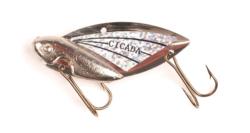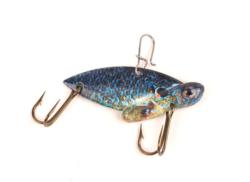Slice the ice
Aggressive or subtle, blade baits offer a unique attraction for hard-water walleyes
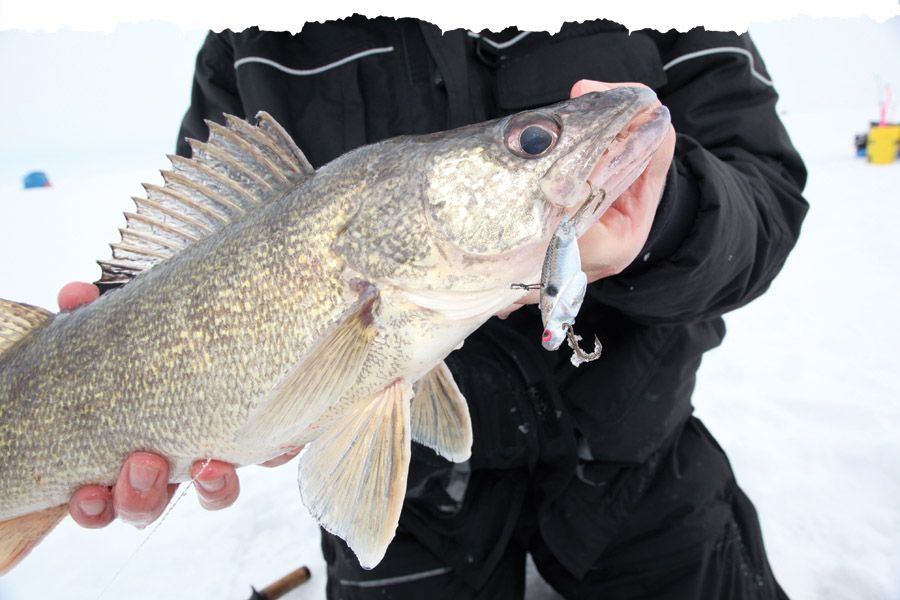
Editor’s note: This article is from FLW Walleye Fishing magazine, offering tips, techniques and tackle reviews for anglers of all skill levels plus in-depth features on the pros of the sport.
——————————————-
The two men walked up to me at a sport show nearly a decade ago. I was standing behind a table where a few photos of giant walleyes, caught under ice, were on display. The pair took one look at the pictures and asked the inevitable question, “What did you get them on?”
“Blade baits,” I said.
They looked at each other, shot me a dirty look and spurted a few expletives.
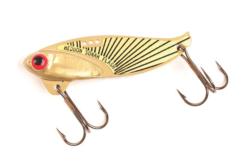
“Walleyes don’t bite blade baits through the ice,” one of them hissed at me.
Oh, how wrong they were.
Fast-forward a decade, and it’s 2011. The number of anglers that utilize blades through the ice is probably just as small as it was 10 years ago. That’s surprising, considering open-water anglers have relied on blade baits in cool-water periods for years for their ability to catch fish in a variety of conditions. Why not continue to do so through the ice?
Walleyes under hard water often go from “just browsing” to lure-smashing in a matter of minutes. A 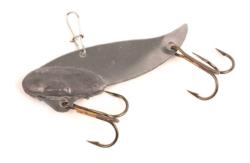 blade bait can be a finesse and power lure, which allows ice anglers to stick walleyes even when they change moods. To ice the cake, blade baits not only trigger neutral and active walleyes, they have the capability to draw fish in to your hole better than other lures. And I’ve got the pictures to prove it.
blade bait can be a finesse and power lure, which allows ice anglers to stick walleyes even when they change moods. To ice the cake, blade baits not only trigger neutral and active walleyes, they have the capability to draw fish in to your hole better than other lures. And I’ve got the pictures to prove it.
The blade
A blade bait is very basic. In most cases, it’s no more than a small, flat, metal blank molded with a piece of lead for weight. When the lure is pulled through the water, the blade creates a distinct vibration.
There are two primary styles of blade baits: straight and curved blades. However, there is a third group of hybrids that also comes into play. Here’s what you should know about each:
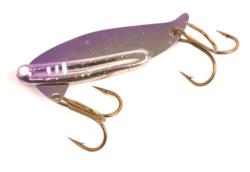
Straight blades
Straight blades are most common. They feature a thin metal blank, typically made of brass. Though similar in shape, the position of the lead on each will cause slight variations in the way the lure falls. Many homemade versions of straight blades have been made from over-the-counter molds. Notable commercial models include the Silver Buddy, Wolverine Tackle Silver Streak, Vib E and Heddon Sonar.
Curved blades have fewer manufactured options. Reef Runner has a patent on its Cicada, which is basically a willow blade with lead molded to the front. The only other lure to feature a willow blade as a blank is the Luhr-Jensen Ripple Tail. No longer in production, the Luhr-Jensen Rattlin’ Ripple Tail is also an option, although difficult to find. These lures put out a lot of vibration with relatively little movement. 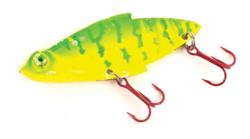
This makes them ideal for drawing in fish.
Hybrid blades
Hybrid blades don’t fit into any one category. Examples include the Worden’s Showdown Blade Bait, which has a slightly cupped, fish-shaped blank with the weight located entirely in the head; the Fish Sense Lures Binsky, with its hooked-tail design, head-weighting and four line attachments for multiple 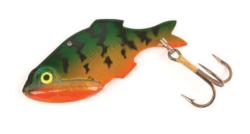 actions; and the Bitzer Creek Zip, which also has a hooked tail that creates a distinct vibration.
actions; and the Bitzer Creek Zip, which also has a hooked tail that creates a distinct vibration.
The right tool for the job
Any mechanic knows that having the right tool is 90 percent of the job. The same goes for blade baits. Each model has its own action and vibration. Ultimately, lake conditions will determine which model works best for a given situation. Certain factors can be considered to help narrow down the selection 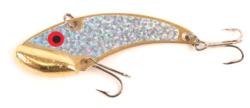 process.
process.
- A straight-blade design, such as the Silver Streak, is often best on large open areas where current is flowing. When current acts on the blade, less vertical movement is required to vibrate it. The larger profile of the straight blade seems to work better in off-colored water and lakes with larger fish.
- Curved blades generally require even less vertical movement (or current) to vibrate. The more compact nature of the curved blades makes them better suited in cleaner water. The quick, ever-
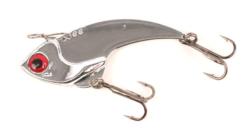
changing flutter and slight roll of the curved blade seem to intrigue walleyes. - Aside from style variances, color plays a major role in most aspects of walleye fishing. Companies such as Silver Buddy and Fish Sense Lures offer only silver and gold models, while Silver Streak and Vib E offer a wide array of wild color options.
- Experiment with different lures. Experience has proved that fish in some lakes show a definite preference for a Silver Streak, and they won’t touch a Vib E, even though the lures are virtually identical. At other lakes the opposite holds true. This might be why some anglers still believe blade baits don’t work through the ice. They haven’t spent enough time experimenting. Don’t make the same
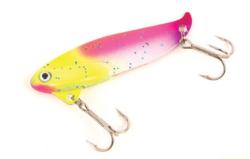
mistake.
Working it
When it comes down to it, catching fish is all about how you work the lure. On most days, the jigging cadence makes the difference between a blank screen and bent rod. There are two parts to this: what you do to draw fish to your hole and what you do when “working” a fish on your electronics.
The biggest mistake most anglers make is “ripping” the blade too hard while working a fish. Pulling a blade so that you feel three or four repetitive vibrations means that the blade is moving too far. When you feel this hard vibration, you’re moving the lure quite a bit farther than you think. This works when fish will chase or are on a suicide bite. Let’s face it, that doesn’t happen often. Slowing down puts the odds in your favor.
The only time to rip a blade bait up and down several feet, typically, is to draw fish in to where they can be worked on sonar. Another solution to draw in fish is to use a large 3/4-ounce model. The oversized blade creates an extreme amount of vibration when ripped. But when fish show up on the electronics, quickly put down the 3/4-ounce blade and choose a “closer” lure.
Sometimes the closer can be a smaller blade, such as a 1/4- or 3/8-ounce model, which is fished in another hole. The slower fall and smaller profile seem to work on skittish walleyes. Other times, the closer might be your favorite jig or a subtle spoon.
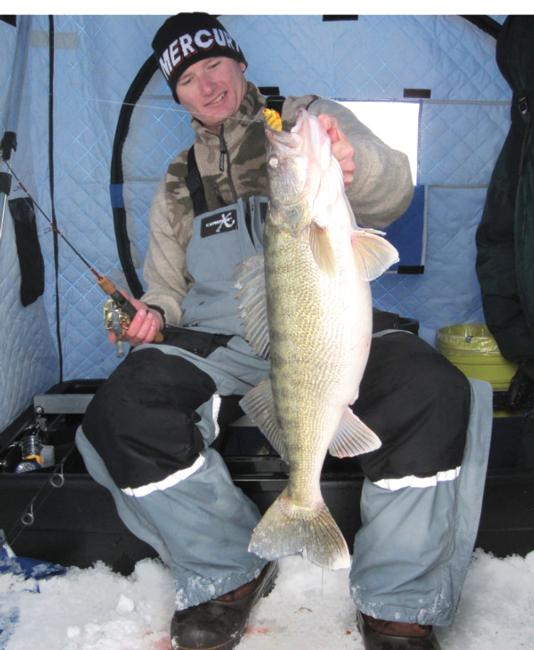
However, you won’t always have the option of an extra rod. When you’re stuck using one rod and one blade bait, three presentations are particularly effective at triggering strikes.
`The Flyby’
To perform “the flyby,” slowly pull the blade up and away from the fish, or right by it when several fish are present on the electronics. Very little action is required. In fact, the key is to move it slowly enough to entice a strike, but just fast enough that the blade barely wobbles. If the walleye doesn’t bite on the first try, lower the bait and try again.
`The Swoosh’
“The swoosh” maneuver is simple. Leave the blade in place, but jiggle the rod just enough to cause it to wobble back and forth. It’s more effective if you add a small minnow on both the front and rear hooks. The minnows will sway in different directions as the blade jiggles. This method is often most successful with small to midsized curved blade baits.
The key to the swoosh is to create movement in the lure without lifting it vertically in the water column. This is a good option if you don’t have success with the flyby method.
`The Rope’
To perform “the rope,” set the blade on the bottom, lift it with a short, but forceful, pull of approximately 1 foot and allow a slight pause before letting it back down. Repeat as needed. This is similar to open-water river jigging, where the lure is lifted and dropped on and off bottom, but the angler always maintains control.
Pull upward slowly enough so that the line never gets “ahead of itself,” meaning that when you stop pulling, the lure doesn’t continue upward. Then lower it so that it falls on a semi-taut line, not a complete free-fall. It would appear to be aggressive, since the lure is constantly moving, yet the rope works best under tough conditions. Many days this is the only way to trigger a bite.
Think of using blade baits through the ice as just another tool in the arsenal. As is the case with any other type of lure, blade baits don’t work all the time. They do, however, offer you a presentation that can go from power to finesse in a matter of seconds. If nothing else, try using a blade to draw in fish, and “close” with your current favorite lure. Then share the photos with your buddies, or else they might never believe you.
Little big details
Blade baits are blade baits; there’s not much that goes into prepping them for the ice. However, a few key steps in the rigging process will save you some heartache before a fish is ever on the line.
- A 1- to 2-foot leader of stiff 20-pound-test fluorocarbon helps reduce tangles.
- A small duo-lock snap swivel provides movement and easy attachment, but isn’t so large that it tangles on the main line.
- Attach the leader to the main line with a No. 8 SPRO Power Swivel, which is small enough that a flasher won’t always detect it and clutter up the screen.
- Attach the snap to the middle hole (when it applies) most of the time, but experiment if fish are attracted but won’t commit.
- For ice fishing, hookups are often more secure by replacing the slipover-style hook with a short-shank treble hook attached with a small split ring. However, experiment with different hooks on different models and blade baits of different sizes.
Rods for blade-bait walleyes
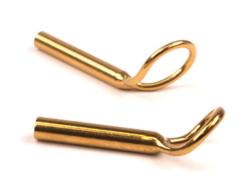
The type of rod you use when blade bait fishing makes a huge difference in the action of the lure. A graphite rod with a parabolic bend is often best. A sensitive rod keeps you from moving the blade too much, and it’s very important that you don’t have too much bounce at the rod tip.
A medium-action rod is good for most blades up to 3/8 ounce; larger blades require a slight rod modification. Since most walleye ice rods aren’t made for lures of 3/4 ounce or heavier, simply cut several inches off the rod tip and replace it with a fly tip. By removing the lightest part of the rod tip, the lure suspends from a thicker portion of the rod. When using larger lures, this will stiffen the action just enough to eliminate bouncing.
